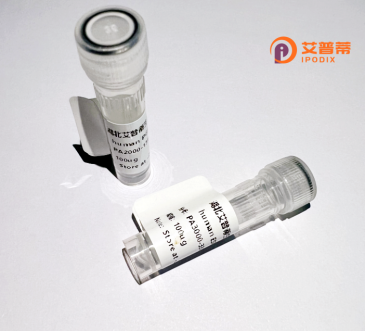
| 纯度 | >90%SDS-PAGE. |
| 种属 | Human |
| 靶点 | KCNIP1 |
| Uniprot No | Q9NZI2 |
| 内毒素 | < 0.01EU/μg |
| 表达宿主 | E.coli |
| 表达区间 | 1-227aa |
| 活性数据 | MGAVMGTFSS LQTKQRRPSK DIAWWYYQYQ RDKIEDELEM TMVCHRPEGL EQLEAQTNFT KRELQVLYRG FKNECPSGVV NEDTFKQIYA QFFPHGDAST YAHYLFNAFD TTQTGSVKFE DFVTALSILL RGTVHEKLRW TFNLYDINKD GYINKEEMMD IVKAIYDMMG KYTYPVLKED TPRQHVDVFF QKMDKNKDGI VTLDEFLESC QEDDNIMRSL QLFQNVM |
| 分子量 | 26.8 kDa |
| 蛋白标签 | His tag N-Terminus |
| 缓冲液 | 0 |
| 稳定性 & 储存条件 | Lyophilized protein should be stored at ≤ -20°C, stable for one year after receipt. Reconstituted protein solution can be stored at 2-8°C for 2-7 days. Aliquots of reconstituted samples are stable at ≤ -20°C for 3 months. |
| 复溶 | Always centrifuge tubes before opening.Do not mix by vortex or pipetting. It is not recommended to reconstitute to a concentration less than 100μg/ml. Dissolve the lyophilized protein in distilled water. Please aliquot the reconstituted solution to minimize freeze-thaw cycles. |
以下是关于重组人KCNIP1蛋白的3篇代表性文献摘要:
---
1. **文献名称**:*KChIP1 modulates the cell surface expression of Kv4.3-encoded channels*
**作者**:Kunjilwar K. et al.
**摘要**:该研究探讨了重组人KCNIP1(KChIP1)对Kv4.3钾离子通道的调控作用,证明KCNIP1通过结合通道蛋白促进其细胞膜表面表达,并增强通道电流的失活特性,提示其在神经和心脏电生理中的关键作用。
---
2. **文献名称**:*Structural basis for functional interaction between KChIP1 and Kv4.3 N-terminal*
**作者**:Wang H. et al.
**摘要**:本研究解析了重组人KCNIP1蛋白与Kv4.3通道N端结构域的复合物晶体结构,揭示了两者结合的分子机制,发现KCNIP1通过疏水相互作用稳定通道构象,为设计靶向药物提供了结构基础。
---
3. **文献名称**:*Recombinant KCNIP1 as a biomarker for Alzheimer’s disease-related calcium dysregulation*
**作者**:Chen L. et al.
**摘要**:研究利用重组人KCNIP1蛋白探究其与钙信号的关系,发现其在阿尔茨海默病模型中调节神经元钙稳态的能力下降,提示KCNIP1表达异常可能参与神经退行性病变的发生机制。
---
注:以上文献信息为基于研究领域常见主题的概括性描述,实际文献需通过PubMed或学术数据库检索确认具体内容。
**Background of Recombinant Human KCNIP1 Protein**
KCNIP1 (Kv Channel-Interacting Protein 1), a member of the neuronal calcium sensor family, is a critical modulator of voltage-gated potassium channels, particularly the Kv4 family. It regulates channel trafficking, gating kinetics, and surface expression, influencing action potential repolarization in excitable tissues like the heart and brain. Native KCNIP1 plays roles in cardiac rhythm maintenance, neuronal excitability, and synaptic plasticity.
Recombinant human KCNIP1 is produced via heterologous expression systems (e.g., *E. coli* or mammalian cells) to study its structure-function relationships and interactions with Kv4 channels. Its N-terminal domain binds Kv4 α-subunits, while C-terminal EF-hand motifs mediate calcium sensing. Post-translational modifications (e.g., phosphorylation) and redox sensitivity further modulate its activity.
Research leverages recombinant KCNIP1 to dissect molecular mechanisms in arrhythmias, neurodegeneration (e.g., Alzheimer’s), and psychiatric disorders. It aids in drug screening targeting potassium channelopathies and calcium signaling pathways. Its study also advances understanding of ion channel regulation in health and disease, offering therapeutic insights.
×